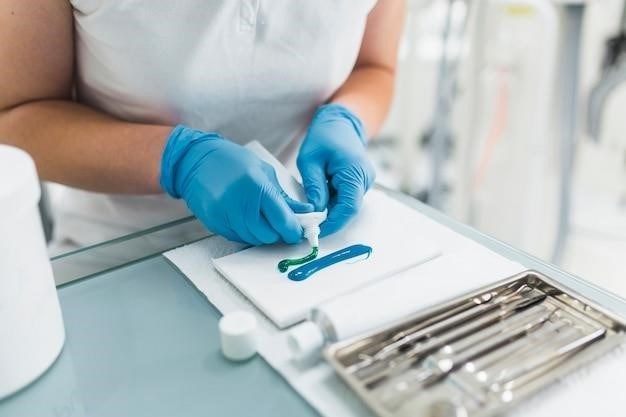
relyx veneer cement instructions

RelyX Veneer Cement⁚ A Comprehensive Guide
This guide provides a comprehensive overview of RelyX Veneer Cement, a light-cure resin cement designed for simple and efficient bonding of porcelain, composite, and ceramic veneers. It offers excellent aesthetic results and ease of use, featuring a customer-preferred delivery and shading system with color-matched try-in pastes. The cement is compatible with a range of light sources and ensures color stability. Detailed instructions for application, curing, and cleanup are included for optimal results.
Introduction to RelyX Veneer Cement
3M RelyX Veneer Cement is a light-cure resin cement specifically formulated for the permanent bonding of porcelain, composite, and ceramic veneers. Its design prioritizes ease of use and exceptional aesthetic outcomes. A key feature is the user-friendly delivery and shading system, complemented by try-in pastes that accurately mimic the final cured cement shade. This allows for precise color matching before final placement, minimizing the risk of discrepancies. The cement’s light-cure-only system contributes to excellent color stability, ensuring long-lasting aesthetic results. Cleanup is straightforward, and the cement is easily dispensed, applied, and seated, streamlining the overall veneer placement procedure. RelyX Veneer Cement is compatible with a wide array of light sources, offering flexibility in clinical settings. The cement’s reliable performance and ease of use make it a popular choice among dental professionals for various veneer applications.
Key Features and Benefits
RelyX Veneer Cement stands out for its exceptional blend of ease of use and superior aesthetic results. A key advantage is its customer-preferred delivery and shading system, simplifying the process of selecting and applying the correct shade. The inclusion of try-in pastes allows for precise color matching before the final cementation, ensuring a seamless and natural-looking result. The cement’s light-cure-only formulation contributes to its remarkable color stability, maintaining the initial shade over time. Its user-friendly design extends to application, dispensing, and seating, making the procedure efficient and less time-consuming. Cleanup is also simplified, minimizing post-procedure effort. Furthermore, RelyX Veneer Cement boasts excellent bonding strength and is compatible with various light sources, offering flexibility and convenience. This combination of features makes it an ideal choice for dentists seeking a reliable and aesthetically pleasing solution for veneer cementation.
Shade Matching and Try-In Pastes
Achieving a natural and aesthetically pleasing result with veneer cementation hinges on precise shade matching. RelyX Veneer Cement simplifies this crucial step with its comprehensive shade selection and the convenient use of try-in pastes. These pastes offer an exceptional color match to the final cured cement, allowing for a realistic preview of the final restoration. Before committing to the permanent cementation, the try-in pastes enable dentists to assess the shade’s integration with the patient’s natural dentition, ensuring a harmonious and undetectable outcome. This process minimizes the risk of shade discrepancies and allows for adjustments if necessary, ultimately enhancing the overall aesthetic success of the procedure. The close resemblance of the try-in paste to the final cured cement eliminates guesswork, leading to increased patient satisfaction and confidence in the final restoration.
Application and Dispensing Techniques
The user-friendly design of RelyX Veneer Cement simplifies application and dispensing. The cement’s delivery system is designed for precise and controlled dispensing, minimizing waste and ensuring efficient use of the material. To begin, ensure the cement syringe tip is clean to maintain optimal flow and prevent clogging. A generous application of cement to the internal surface of the veneer is recommended to ensure complete coverage and strong bonding. Careful application prevents excess cement from interfering with the seating process. The cement should be applied evenly, avoiding pooling or excessive buildup in any one area. This technique promotes a smooth and even cement layer, leading to a secure and aesthetically pleasing final result. Proper application techniques, along with the cement’s easy handling, contribute to a streamlined and efficient veneer cementation procedure.
Seating and Light-Curing Procedures
After applying RelyX Veneer Cement, carefully seat the veneer onto the prepared tooth using gentle pressure. Ensure the veneer is properly positioned before proceeding to the light-curing stage. Precise seating is crucial for optimal adhesion and a natural-looking result. For multiple veneers, a sequential seating approach, starting from one end, is recommended to ensure accurate placement and avoid disturbing previously seated restorations. Once the veneer is securely seated, initiate light curing. Use a light source emitting wavelengths within the 400-500 nm range. Direct the light source towards the facial surface of the veneer, using a small-diameter light guide for precise curing, and maintain a consistent distance to ensure even polymerization. A recommended light-curing time is 20 seconds per veneer, though the manufacturer’s instructions should always be consulted. This thorough light curing process is essential to achieve the optimal bond strength and longevity of the restoration.
Excess Cement Removal and Clean-Up
Following light curing, promptly remove any excess RelyX Veneer Cement. The ease of cleanup is a key advantage of this cement. For optimal results, wait until the excess cement becomes slightly tacky before attempting removal. This typically takes 2-3 minutes after light curing. Use a sharp scaler or other suitable instrument to carefully remove the excess material from the margins of the veneer and the surrounding tooth structure. Avoid excessive pressure to prevent damage to the restoration or the adjacent teeth. Gentle scraping and wiping motions are recommended. A specialized cement removal tool might also be used to help aid in the removal of the excess material. Thoroughly clean the area using a soft brush and water spray or an appropriate cleaning solution recommended by the manufacturer. Ensure all excess cement is completely removed to maintain aesthetics and prevent potential irritation or complications. The final result should be a clean, smooth restoration seamlessly integrated with the natural tooth structure.
Final Curing and Setting Time
After excess RelyX Veneer Cement is removed, a final curing step is crucial to ensure complete polymerization and optimal bond strength. The cement is a light-cure resin, requiring exposure to a visible light source within the 400-500 nm wavelength range. The recommended curing time varies depending on the light source’s intensity and the thickness of the cement layer. Refer to the manufacturer’s instructions for specific recommendations. Generally, a curing time of 20 seconds using a small diameter light guide directly on the facial surface of the veneer is sufficient to achieve complete curing. For larger restorations or areas with thicker cement layers, longer curing times may be necessary to ensure complete polymerization throughout the cement layer. Insufficient curing can compromise the bond strength and longevity of the veneer. After the final curing, allow the cement to set fully according to the manufacturer’s recommendations, typically 5 minutes, before proceeding with any post-operative procedures. This ensures the stability of the veneer and prevents any displacement.

Compatibility with Adhesive Systems
RelyX Veneer Cement’s compatibility is optimized for use with 3M ESPE adhesive systems. While it may exhibit bonding capabilities with other adhesive systems, using it with a 3M ESPE system ensures optimal performance and predictable results. The manufacturer explicitly recommends this approach to guarantee the most reliable bond strength and long-term stability of the veneer. Choosing a compatible adhesive system is critical for successful veneer placement. The interaction between the cement and the adhesive significantly influences the overall bond strength. Using an incompatible adhesive may lead to weakened bonding, increased risk of veneer debonding, and potential complications. Therefore, adhering to the manufacturer’s recommendations and utilizing a 3M ESPE adhesive system is strongly advised for achieving reliable and durable veneer restorations. This approach minimizes the risk of failure and ensures a successful clinical outcome. Always consult the instructions for use of both the RelyX Veneer Cement and the chosen adhesive system for detailed guidance on proper application and compatibility.
Troubleshooting Common Issues
During the application of RelyX Veneer Cement, several issues might arise. Incomplete curing, often resulting from insufficient light exposure or inadequate light intensity, can lead to a weak bond. To address this, ensure proper light curing using a suitable light source and the recommended exposure time. Excess cement that remains after seating can be easily cleaned using a scaler or other appropriate instrument. However, if excess cement remains despite cleaning, it may interfere with the marginal integrity of the restoration. Careful application and precise dispensing techniques can help minimize this problem. Inadequate shade matching can compromise the aesthetic outcome. Careful selection of the appropriate shade, utilizing try-in pastes for accurate color assessment, is essential. If a weak bond occurs, it may be due to improper surface preparation of the tooth or the veneer. Always follow the recommended protocols for etching, bonding, and cementation. In the event of any difficulty, consult the manufacturer’s instructions for use or seek professional assistance to troubleshoot effectively and ensure successful restoration.
Recommended Light Sources and Curing Times
Achieving optimal polymerization of RelyX Veneer Cement necessitates the use of appropriate light sources and adherence to specified curing times. While the cement is compatible with a wide range of light sources, the manufacturer’s instructions should always be consulted for specific recommendations. Generally, a high-intensity visible light curing unit operating within the 400-500 nm wavelength range is recommended. The exact curing time will vary depending on the light source’s intensity and the thickness of the cement layer. For instance, a thinner layer might require a shorter curing time compared to a thicker layer. Insufficient curing can lead to a weakened bond and potential restoration failure, while excessive curing may generate unnecessary heat and potentially harm the surrounding tissues. To ensure complete polymerization and a robust bond, always follow the manufacturer’s guidance on recommended light sources and their corresponding curing times for RelyX Veneer Cement. Consistent and thorough light curing is pivotal for achieving a successful and long-lasting veneer restoration.
Post-Cementation Care and Instructions
Following the successful cementation of veneers using RelyX Veneer Cement, proper post-operative care is crucial for ensuring the longevity and integrity of the restoration. Patients should be advised to avoid consuming excessively hard or sticky foods immediately after the procedure to prevent any potential dislodgement of the veneers. Maintaining meticulous oral hygiene is paramount. Patients should be instructed to brush and floss gently, avoiding excessive pressure on the cemented veneers. Regular dental check-ups are recommended to monitor the condition of the veneers and to address any potential issues promptly. The dentist may also provide specific post-operative instructions tailored to the individual patient’s needs and the specifics of their case. These might include dietary restrictions for a short period, recommendations for pain management if necessary, and advice on managing any potential sensitivity. By following these post-cementation care instructions, patients can significantly contribute to the long-term success of their veneer restorations and maintain optimal oral health.
Manufacturer’s Instructions and Resources
For complete and up-to-date instructions on the use of 3M RelyX Veneer Cement, always refer to the manufacturer’s official Instructions for Use (IFU) document. This document provides detailed information on all aspects of the cementation procedure, including preparation, application techniques, curing times, and post-operative care. The IFU should be considered the definitive source for proper usage and should be carefully reviewed by dental professionals before commencing any procedure. 3M also provides various resources to support the use of their products. These may include online videos demonstrating proper application techniques, technical support documentation answering frequently asked questions, and material safety data sheets (MSDS) detailing the composition and safety precautions associated with the cement. Accessing these resources ensures that dental professionals have the necessary information and support to effectively and safely utilize RelyX Veneer Cement. Remember that adherence to the manufacturer’s guidelines is crucial for successful and predictable outcomes.

